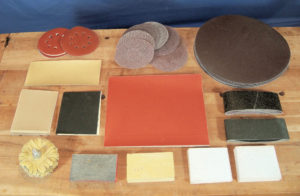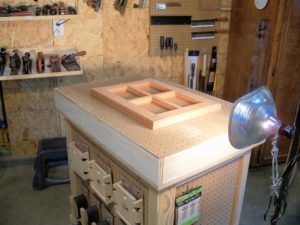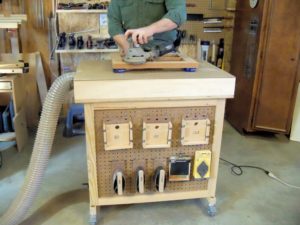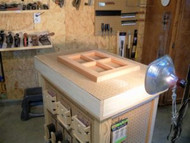I Hate to Say It, But...
10 16 2013
After our recent post on pore filling through slurry sanding a reader mentioned that I had not covered the actual proceedure, and had only said: "in the same order and grit". Mea Culpa. I was unclear and should have said; "in the same order and grit as you would normally sand your project." The only change to do the slurry sanding is to use a wetting agent (light cut shellac or oil finish) and wet/dry sandpaper in the final one or two steps. The rest is the same.

Now if you want to know what grits to start and end with, and how far to "step" between grits... I hate to say it, but...it all depends on what you are doing. Start with what the finish is to be. If you are painting and want to see the wood grain in the paint, then you can finish pretty quickly, sanding to 120 and done. But if the paint is to be smooth and glossy, you will need to sand down to 220 or even 400 to get the polished look you want. A clear oil type finish requires less sanding than a stained piece since the stain will instantly settle into every scratch on the surface and stick out like a sore thumb. The slurry sanding technique should be sanded down to 400 or even lower since the entire purpose is to acheive a smooth finish. So here are a few tips and tricks to help guide you:

Use a low angle light to find and eliminate defects BEFORE finishing! All sanding leaves scratches behind, even at 3600 grit. The trick is to insure that all the scratches are as small as you want and very uniform in size so that they blend together. In reality when we say that there is a scratch in the face, what we really mean is that there is a random scratch that is larger than the background scratches. A strong light shown across the surface at a very low angle will reveal these outsized defects by elongating shaows the same way a setting sun does.
Try wetting your surface before sanding. All finishes will raise the grain of your wood to a degree as the finish wets the fibers and loose ends curl up. Oils do this much less than water based finishes, but they all do it. Wiping the surface with a cloth dampened with water before sanding will raise these loose fibers so you need not sand as much between finishing steps. Sand with your first two grits, then wet the surface, let it dry and finish the sanding steps. You will be amazed at how much less fuzz you get once you begin applying finishes.
 Use proper dust collection. As you sand, not only are wood particles being cut from the high spots of your part, but often bits of the abrasive from the paper come loose as well. Good quality paper reduces this, but it happens. Then you run the risk of having these 100 grit particles under your 150 grit paper as you sand away. As you can guess, one or two of these bits will just leave big scratches all over the surface. Good dust collection during sanding and wiping off the surface between grits will greatly diminish this issue and will help you get more life from your paper.
Use proper dust collection. As you sand, not only are wood particles being cut from the high spots of your part, but often bits of the abrasive from the paper come loose as well. Good quality paper reduces this, but it happens. Then you run the risk of having these 100 grit particles under your 150 grit paper as you sand away. As you can guess, one or two of these bits will just leave big scratches all over the surface. Good dust collection during sanding and wiping off the surface between grits will greatly diminish this issue and will help you get more life from your paper.
As much as I do hate to say it, there really is no 'one size fits all' instruction for what grits to start with, how far to 'step down' between grits, and where to stop. Generically, I like to start with 80 grit, then 120, 220, and 320 if needed. Soft woods might skip the 80 grit and finish with 400, hard woods may end at 220 but add 100 after the 80 grit. A really fine furniture piece might see me sanding all the way to 600 in 6 or 7 steps. When in doubt, err on the side of caution. Use more steps with smaller 'jumps' between grits, and over time you will develop a feel for what works.
We hope that you find this information useful, and we would love to share your tips and tricks with our readers as well! You can share them by commenting here on this blog, on our Facebook page, or via Twitter. -2Sand.com

